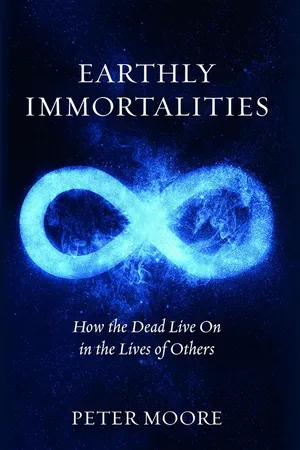![]()
REFERENCES
PREFACE
1 Peter Moore, Where are the Dead? Exploring the Idea of an Embodied Afterlife (New York and London, 2017).
INTRODUCTION
1 Edward Young (1683–1765), The Complaint: or, Night-thoughts (London, 1742); Night Seventh, 507–10.
2 See, for example, Yvonne Sherwood, A Biblical Text and its Afterlives: The Survival of Jonah in Western Culture (Cambridge, 2000).
3 For a book based on the most literal understanding of what a literary afterlife is, see Bernard A. Drew, Literary Afterlife: The Posthumous Continuations of 325 Authors’ Fictional Characters (Jefferson, NC, 2009). What is it, asks Drew, about certain literary characters that impel new authors to make them live on long after their original authors have died?
4 Edward Shils, Tradition (London, 1981), pp. 24 and 15.
5 Ibid., p. 167.
6 Auguste Comte, Catéchisme positiviste (Paris, 1852); The Catechism of Positive Religion, trans. Richard Congreve (London, 1858), pp. 76–7.
7 Karl Marx, The Eighteenth Brumaire of Louis Bonaparte (New York, 1963), p. 15. Compare this with Voltaire’s description of history as ‘nothing but a pack of tricks we play upon the dead’ (in a letter to Pierre Robert Le Cornier de Cideville, 9 February 1757). See Complete Works of Voltaire (Banbury, 1971), vol. CI, p. 448.
8 See The Poems of Alice Meynell (New York, 1923), p. 44.
9 In some conceptions of post-mortem existence, individual selfhood is abolished or transcended. In these cases, arguably, the term ‘afterlife’, with its implication of personal continuance, should not be used.
10 If ‘earthbound’ ghosts or ‘haunting’ apparitions were forms of the surviving dead, however, they might well be regarded as in some sense the subjects of their own earthly afterlives. Alternatively they might be regarded as ‘supernatural’ cases of what I defined in Chapter Two as ‘staying on’. Vivid examples of how the surviving dead might share their earthly afterlives with the living are given in Richard Lloyd Parry, Ghosts of the Tsunami: Death and Life in Japan’s Disaster Zone (London, 2017).
11 See David R. Unruh, ‘Death and Personal History: Strategies of Identity Preservation’, Social Problems, XXX (1983), pp. 340–51.
12 John Ellis McTaggart, ‘The Relation of Time and Eternity’, Mind, XVIII (1909), pp. 343–62 (p. 343).
13 For more on this, see Eleanore Stump and Norman Kretzmann, ‘Eternity’, Journal of Philosophy, LXXVIII (1981), pp. 429–58.
14 Christopher Cherry, ‘Can My Survival Be Subrogated?’, Philosophy, LIX (1984), pp. 443–56; here pp. 450, 448.
15 The OED gives three meanings for this word: (1) a person’s later years of life; (2) a post-mortem existence; (3) a renewed use or influence. One of the examples given to illustrate the third meaning describes a particular disused railway line as having an ‘afterlife’ as a long-distance footpath.
16 R. S. Thomas, ‘The Country Clergy’, in Collected Poems, 1945–1990 (London, 1993), p. 82.
17 The Greek gods, for example, had to drink ambrosia to maintain their existence.
18 For example, the Hindu and Norse mythologies both envisage a time when the universe, including most of the gods, will be destroyed – although this destruction is followed by a new creation.
19 Consider also the words of Hannah Arendt, The Human Condition (Chicago, IL, 1958), p. 18: ‘Immortality means endurance in time, deathless life on this earth and in this world as it was given, according
to Greek understanding, to nature and the Olympian gods. Against this background of nature’s ever-recurring life and the gods’ deathless and ageless lives stood mortal men, the only mortals in an immortal but not eternal universe, confronted with the immortal lives of their gods but not under the rule of an eternal God.’ Compare with this Thomas Browne’s statement: ‘The created World is but a small Parenthesis in Eternity’ (Urn-Burial, 1658).
20 Andrew Bennett, ‘On Posterity’, Yale Journal of Criticism, XII (1999), pp. 131–44 (p. 131). Elsewhere Bennett quotes William Hazlitt (‘On the Living Poets’, 1818) on how the greatest poets can afford to wait for lasting fame: ‘If their works have the seeds of immortality in them, they will live; if they have not they care little about them as theirs.’ Romantic Poets and the Culture of Posterity (Cambridge, 1999), p. 4.
21 T. C. Finlayson, Biological Religion (Manchester, 1885), pp. 67–8. The work under criticism was Henry Drummond’s Natural Law in the Spirit World (New York, 1884).
22 There is, of course, a subtle difference between being ‘immune to’ and ‘immune from’ something. The former implies an intrinsic immunity, the latter an immunity dependent upon some external factor (for example, the law, military power, God) – an immunity that could, therefore, be withdrawn.
23 As Denis Diderot observes (Letter 4 to Falconet, 4 February 1766), ‘posterity properly begins only from the moment we cease to exist; but it speaks to us for a long time before that’ (La postérité ne commence proprement qu’au moment où nous cessons d’être; mais elle nous parle longtemps auparavant). See Mémoires, correspondance et ouvrages inédits de Diderot, vol. III (Paris, 1830), p. 218. For an analysis of the hopes invested in posterity by Diderot and his contemporaries, see Carl. L. Becker, The Heavenly City of the Eighteenth-century Philosophers (New Haven, CT, and London, 1932), Lecture IV: ‘The Uses of Posterity’.
24 See J. V. Luce, ‘Immortality in Plato’s Sympo...
